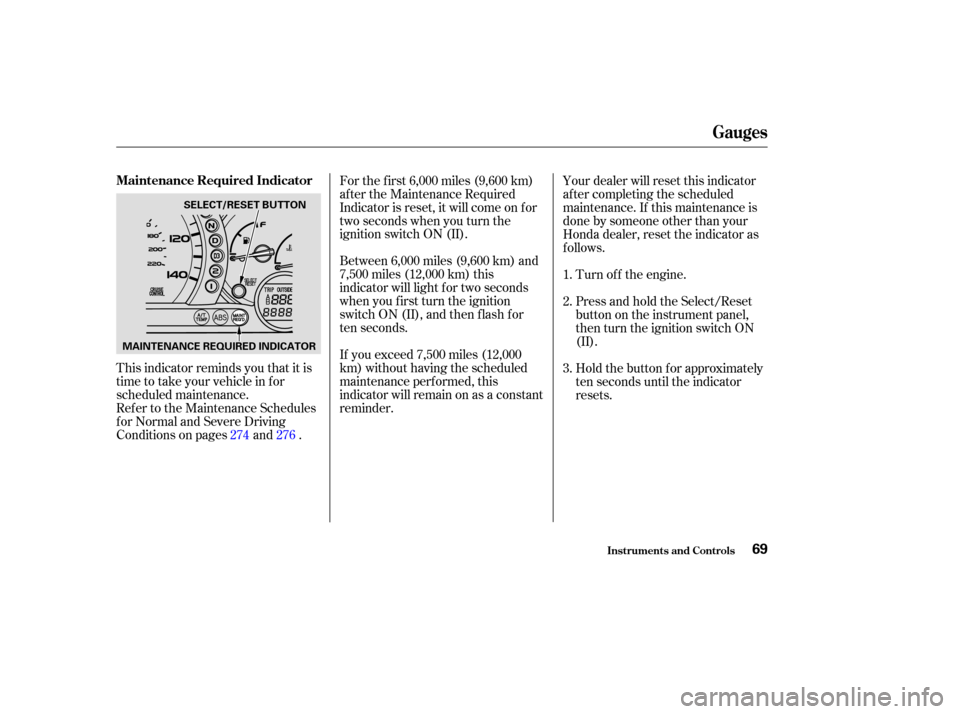2003 HONDA PILOT maintenance schedule
[x] Cancel search: maintenance schedulePage 1 of 392

Use these links (and links throughout this manual) to navigate through\
this reference.
For a printed owner's manual, click on authorized manuals or go to www.h\
elminc.com.
Contents
Owner's Identification Form
Introduction ........................................................................\
................................................................. i
A Few Words About Safet y........................................................................\
.........................................ii
Important Handling Information........................................................................\
.............................iii
Your Vehicle at a Glanc e........................................................................\
............................................ .2
Driver and Passenger Safety ........................................................................\
..................................... .5
Proper use and care of your vehicle's seat belts, and Supplemental Restr\
aint System.
Instrume nt panel indicator and gauge, and how to use dashboard and steering colu\
mn controls.
Comfort and Convenience Features ........................................................................\
..................... .117
How to operate the climate control system, the audio system, and other c\
onvenience features.
What gasoline to use, how to break -in your new vehicle, and how to load luggage and other cargo.
The proper way to start the engine, shift the transmission, and park, pl\
us towing a trailer.
The Maintenance Schedule shows you when you need to take you r vehicle to the dealer.
Appearance Car e........................................................................\
..................................................... .267
Tips on cleaning and protecting your vehicle. Things to look for if your\
vehicle ever needs body repairs.
This section covers several problems motorists sometimes experience, an d how to handle them.
ID numbers, dimensions, capacities, and technical information.
A summary of the warranties covering your new Acura, and how to contact \
us.
How to order manuals and other technical literature.
Index........................................................................\
........................................................................\
...... I
Service Information Summary
A summary of information you need when you pull up to the fuel pump.
Before Driving........................................................................\
..........................................................215
Driving ........................................................................\
..................................................................... .229
Maintenance........................................................................\
.............................................................269
Taking Care of the Unexpecte d........................................................................\
..............................325
Warranty and Customer Relations (U.S. and Canada)................................................................373
Authorized Manuals (U.S. only)........................................................................\
..............................377 Technical Informatio n........................................................................\
............................................ .359
2003 Pilot Online Reference Owner's Manual
Instruments and Controls........................................................................\
........................................ .59
Page 3 of 392

Calif ornia Proposition 65 WarningThis product contains or emits chemicals known to the State of
Calif ornia to cause cancer and birth def ects or other reproductive harm. Congratulations! Your selection of a 2003 Honda Pilot was a wise investment.
It will give you years of driving pleasure.
One of the best ways to enhance the enjoyment of your new Honda is to
read this manual. In it, you will learn how to operate its driving controls and
convenience items. Af terwards, keep this owner’s manual in your vehicle so
youcanrefertoitatanytime.
Several warranties protect your new Honda. Read the warranty booklet
thoroughly so you understand the coverages and are aware of your rights
and responsibilities.
Maintaining your vehicle according to the schedules given in this manual
helps to keep your driving trouble-f ree while it preserves your investment.
When your vehicle needs maintenance, keep in mind that your Honda
dealer’s staf f is specially trained in servicing the many systems unique to
your Honda. Your Honda dealer is dedicated to your satisf action and will be
pleased to answer any questions and concerns. As you read this manual, you will
f ind inf ormation that is preceded by
a
symbol. This
inf ormation is intended to help you
avoid damage to your Honda, other
property, or the environment.
Introduction
WARNING:
i
Page 10 of 392

You’ll f ind many saf ety
recommendations throughout this
section, and throughout this manual.
Therecommendationsonthispage
are the ones we consider to be the
most important.Excessive speed is a major f actor in
crash injuries and deaths. Generally,
the higher the speed the greater the
risk, but serious accidents can also
occur at lower speeds. Never drive
f aster than is saf e f or current
conditions, regardless of the
maximum speed posted.
While airbags can save lives, they
can cause serious or fatal injuries to
occupants who sit too close to them,
or are not properly restrained.
Inf ants, young children, and short
adults are at the greatest risk. Be
sure to f ollow all instructions and
warnings in this manual. (See page
.)
Having a tire blowout or a
mechanical f ailure can be extremely
hazardous. To reduce the possibility
of such problems, check your tire
pressures and condition f requently,
and perform all regularly scheduled
maintenance. (See page .)
Children are saf est when they are
properly restrained in a back seat,
notthefrontseat.Achildwhoistoo
smallforaseatbeltmustbeproperly
restrained in a child saf ety seat. (See
page .) Alcohol and driving don’t mix. Even
one drink can reduce your ability to
respond to changing conditions, and
your reaction time gets worse with
every additional drink. So don’t drink
and drive, and don’t let your f riends
drink and drive, either.
A seat belt is your best protection in
all types of collisions. Airbags
supplement seat belts, but airbags
are designed to inf late only in a
moderate to severe f rontal collision.
So even though your vehicle is
equipped with airbags, make sure
you and your passengers always
wear your seat belts, and wear them
properly. (See page .)
15 9
21 272
Driver and Passenger Saf ety
Important Saf ety Precautions
Always Wear Your Seat BeltBe Aware of Airbag Hazards Control Your Speed
K eep Your Vehicle in Saf e
Condition
Restrain All Children Don’t Drink and Drive
6
Page 73 of 392

This indicator reminds you that it is
time to take your vehicle in for
scheduled maintenance.
Ref er to the Maintenance Schedules
f or Normal and Severe Driving
Conditions on pages and .For the f irst 6,000 miles (9,600 km)
af ter the Maintenance Required
Indicator is reset, it will come on f or
two seconds when you turn the
ignition switch ON (II).
Between 6,000 miles (9,600 km) and
7,500 miles (12,000 km) this
indicator will light f or two seconds
when you first turn the ignition
switch ON (II), and then f lash f or
ten seconds.
If you exceed 7,500 miles (12,000
km) without having the scheduled
maintenance perf ormed, this
indicator will remain on as a constant
reminder.
Your dealer will reset this indicator
af ter completing the scheduled
maintenance. If this maintenance is
done by someone other than your
Honda dealer, reset the indicator as
f ollows.
Turn of f the engine.
Press and hold the Select/Reset
button on the instrument panel,
then turn the ignition switch ON
(II).
Hold the button f or approximately
ten seconds until the indicator
resets.
1.
2.
3.
274 276
Gauges
Inst rument s and Cont rols
Maintenance Required Indicator
69
MAINTENANCE REQUIRED INDICATOR SELECT/RESET BUTTON
Page 220 of 392

Help assure your vehicle’s f uture
reliability and perf ormance by paying
extra attention to how you drive
during the f irst 600 miles (1,000 km).
During this period:Avoid full-throttle starts and rapid
acceleration. Youshouldfollowthesesamere-
commendations with an overhauled
or exchanged engine, or when the
brakes are replaced.
Do not change the oil until the
recommended time or mileage
intervalshowninthemaintenance
schedule.
Avoidhardbraking.Newbrakes
need to be broken-in by moderate
use f or the f irst 200 miles (300
km). We also recommend that you do not
tow a trailer during the f irst 500
miles (800 km).
Your Honda is designed to operate
on unleaded gasoline with a pump
octane number of 86 or higher. Use
of a lower octane gasoline can cause
a persistent, heavy metallic rapping
noise in the engine that can lead to
mechanical damage.
We recommend gasolines containing
detergent additives that help prevent
f uel system and engine deposits.
Using gasoline containing lead will
damage your vehicle’s emissions
controls. This contributes to air
pollution.
Premium f uel is recommended when
towing in certain conditions (see
page ).
256
Break-in Period, Gasoline
Bef ore Driving
Break-in Period Gasoline
216
Page 226 of 392

The condition of your vehicle and
your driving habits are the two most
important things that affect the fuel
mileage you get.
Always maintain your vehicle accord-
ing to the maintenance schedule.
This will keep it in top operating
condition.A cold engine uses more f uel than a
warm engine. It is not necessary to
‘‘warm-up’’ a cold engine by letting it
idle f or a long time. You can drive
away in about a minute, no matter
how cold it is outside. The engine
will warm up f aster, and you get
better f uel economy. To cut down on
the number of ‘‘cold starts,’’ try to
combine several short trips into one.
You can improve f uel economy by
driving moderately. Rapid acceler-
ation, abrupt cornering, and hard
braking use more f uel.
Always drive in the highest gear that
allows the engine to run and acceler-
ate smoothly.
Depending on traf f ic conditions, try
to maintain a constant speed. Every
time you slow down and speed up,
your vehicle uses extra f uel. Use the
cruise control, when appropriate, to
increase f uel economy.
The air conditioning puts an extra
load on the engine which makes it
usemorefuel.Turnoff theA/Cto
cut down on air conditioning use.
Use the f low-through ventilation
when the outside air temperature is
moderate.
In winter, the build-up of snow on
your vehicle’s underside adds weight
and rolling resistance. Frequent
cleaning helps your f uel mileage and
reduces the chance of corrosion. An important part of that mainte-
nance is the (see page ). For
example, an underinf lated tire
causes more ‘‘rolling resistance,’’
which uses f uel. It also wears out
f aster, so check the tire pressure at
least monthly. 281
Vehicle Condition
Driving Habits
Owner Maintenance
Checks
Bef ore Driving
Fuel Economy
222
Page 260 of 392

Many states and provinces require
special exterior mirrors when towing
a trailer. Even if they don’t, you
should install special mirrors if you
cannot clearly see behind you, or if
the trailer creates a blind spot.
We also recommend that you carry a
f ull-size spare wheel and tire f or your
trailer. Ask your trailer sales or
rental agency where and how to
store the spare. See page f or proper tire size,
page f or how to store a f ull-sized
wheel and tire, and page for
inf ormation on changing a f lat tire.
Remember to unhitch the trailer
bef ore changing a f lat.When preparing to tow, and bef ore
driving away, be sure to check the
f ollowing:
The vehicle has been properly
serviced, and the brakes,
suspension, and cooling system
are in good operating condition. If
you tow f requently, f ollow the
Severe Conditions maintenance
schedule. The lights and brakes on your
vehicle and the trailer are working
properly.
Your vehicle tires and spare are in
good condition and properly
inf lated (see page ).
The trailer tires and spare are in
good condition and inf lated as
recommended by the trailer
maker.
When towing a trailer, we
recommend that you carry a f ull-size
spare wheel and tire f or your vehicle.
Using the compact spare that came
with the Pilot may adversely affect
vehicle handling.
Allitemsonandinthetrailerare
properly secured and cannot shif t
while you drive. Thehitch,safetychains,andany
other attachments are secure. All weights and loads are within
limits (see pages and ). The trailer has been properly
serviced and is in good condition.Towing perf ormance can be
af f ected by high altitude, high
temperature, or climbing steep
grades. Theref ore, premium
f uel is recommended when
towing more than 3,500 lbs
(1,590 kg).
313
340 335 308
247 249
Trailer Mirrors Spare TiresPre-T ow Checklist
Towing a Trailer
Driving256
Page 267 of 392

The f ollowing pages contain practical
tips on basic of f -highway operation.
Driving of f -highway can be hard on a
vehicle. Bef ore you leave the
pavement, be sure all scheduled
maintenance and service has been
done, and that you have inspected
your vehicle. Pay special attention to
the condition of the tires, and use a
gauge to check the tire pressures.Of f -highway, the general rule is to
keep your speed low. Of course,
you’ll need enough speed to keep
moving forward. But at higher
speeds, you have less time to assess
conditions and make good decisions.
There’s also a greater chance of
sliding if you brake or turn too
quickly on wet soil, gravel, or ice. In
any situation, never go f aster than
conditions allow.Generally, the best of f -pavement
braking technique is to gently
depress the brake pedal, then
increase pressure as more braking is
needed. Avoid hard braking. Keep in
mind that you will usually need more
time and distance to brake to a stop
on unpaved surf aces.
After you return to the pavement,
caref ully inspect your vehicle to
make sure there is no damage that
could make driving it unsaf e. Check
the tires for damage and for proper
pressure. If you need to brake hard because of
an emergency, apply steady, even
pressure to the brake pedal. Do not
pump the brakes; let the anti-lock
braking system pump them f or you.
If you pump the brakes, the anti-lock
cannot work as ef f iciently, and your
stopping distance may be increased.
Forbettertractiononallsurfaces,
accelerate slowly and gradually build
up speed. If you try to start too fast
on wet soil, mud, snow, or ice, you
might not have enough traction to
get underway. You may even dig
yourself into a hole. Starting with the
shif t lever in second gear (2) will
help get you to a smooth start on
snow and ice.
CONT INUED
Cont rolling Speed
Check Out Your Vehicle
A ccelerat ing and BrakingDriving T ips
Off-Highway Guidelines
Driving263